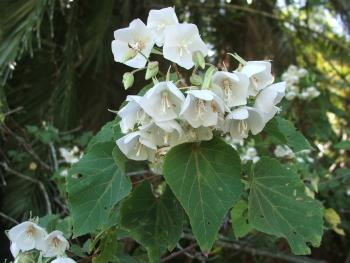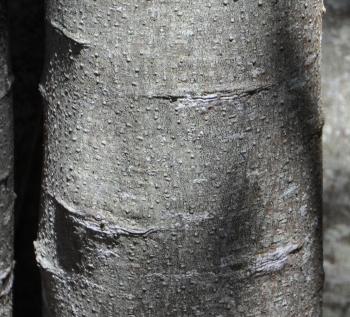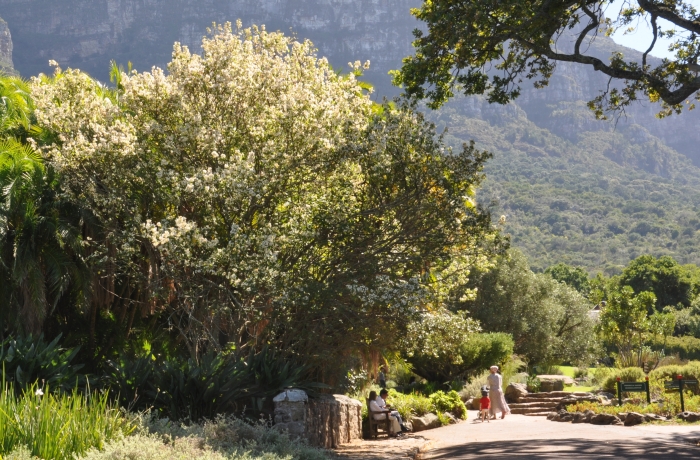Dombeya tiliacea
Dombeya tiliacea (Endl.) Planch.
Family: Malvaceae
Common names: forest wild pear, forest dombeya, little-dog-rose (Eng.); bosblompeer, bosdrolpeer (Afr.), ibunda (isiZulu), utyibo (isiXhosa)
SA Tree No: 472
Introduction
A pretty shrub or small tree, with white flowers in late summer to autumn, suitable for sun or semi-shade.

Description
Description
Dombeya tiliacea is a lovely shrub, sometimes scrambling, or a small deciduous tree, 3–4 m, up to 10 m tall, usually multi-stemmed. Bark is rough, dark grey. Branchlets slender, with pale lenticels and leaf scars. New growth is hairy.

Leaves are simple, ovate, heart-shaped at the base, often elongating towards the tip, sometimes shallowly 3-lobed at the apex, 30–100 × 20–80 mm, thin textured, dark green and slightly hairy, becoming smooth with age. Margin is scalloped or toothed. Usually 5-veined from the base, but may be 3- or 7-veined, and veins are raised on the underside of the leaves. Stalks 20–65 mm long, hairy.

Loose clusters of fairly large white flowers, occasionally with a pink throat, are produced in the axils of the upper leaves, in late summer and autumn (March to July). Each flower is 25–30 mm in diameter, sweet-scented and the clusters contain 2–9 flowers. Fruit is a small, rounded, hairy capsule inside the rusty brown remains of the flowers, splitting to release several small, 5 × 7 mm, rough, 3-sided seeds, in winter to early summer (June to December).

Conservation Status
Status
Dombeya tiliacea is not threatened and is assessed as Least Concern (LC).
Distribution and habitat
Distribution description
Dombeya tiliacea grows on the edges of forest, in coastal forest, thornveld and in mixed scrub, from about Port Elizabeth in the Eastern Cape, to northern KwaZulu-Natal, from the coast and inland to the foothills of the Drakensberg, to about 1 500 m above sea level.
Derivation of name and historical aspects
History
The genus Dombeya is named for Joseph Dombey (1742–1794), a French botanist and explorer in Peru and Chile. This species is named for its resemblance to linden trees and lime trees, Tilia spp. (Malvaceae) The common name drolpeer or wildpear comes from the resemblance of flowering dombeyas to pear trees (Pyrus spp., Rosaceae) in full flower, but they are not related to pears.
Dombeya is a large genus of about 300 species that occur in Africa, Madagascar and the Mascarene Islands, with 8 species in South Africa. The other southern African species are D. autumnalis, D. burgessiae, D. cymosa, D. kirkii, D. pulchra, D. quinqueseta and D. rotundifolia in which 2 varieties are recognised: var. rotundifolia and var. velutina.

Ecology
Ecology
The flowers attract many different insects, including bees and day-flying moths, and is a good tree to attract wildlife to the garden. It loses its leaves when conditions are cold or dry. The tree is often parasitised by a mistletoe, Erianthemum dregei.

Uses
Use
Dombeya tiliacea is a good shrub for background plantings or an informal hedge. It is a good one to plant near the bird bath as it is favoured by birds as secluded and sheltered spot, where they feel safe from predatory birds and cats, yet it allows in enough sun for them to dry out and warm up in.
Dried flowers are also decorative, and can be used in pot-pourri.
Growing Dombeya tiliacea
Grow
Dombeya tiliacea is easy to grow from cuttings and seed. Sow seed in spring or early summer. Take semi-hardwood cuttings in spring, when the sap starts to flow again after the winter resting period.
Grow it in fertile, well-drained soil in full sun, semi-shade or light shade. It performs best in a moderate to well-watered site and will survive a dry winter. It is able to withstand frost and can be grown on the Highveld.
References
- Boon, R. 2010. Pooley's trees of eastern South Africa, a complete guide. Flora & Fauna Publications Trust, Durban.
- Foden, W. & Potter, L. 2005. Dombeya tiliacea (Endl.) Planch. National Assessment: Red List of South African plants version 2017.1. Accessed on 2018/07/12
- Global Plants: Dombey, Joseph. https://plants.jstor.org/stable/10.5555/al.ap.person.bm000002124 Accessed on 12 July 2018
- Jackson, W.P.U. 1990. Origins and meanings of names of South African plant genera. University of Cape Town.
- Palmer, E. & Pitman, N. 1972. Trees of southern Africa. Balkema, Cape Town.
- Verdoorn, I.C. & Herman, P.P.J. 1986. Revision of the genus Dombeya (Sterculiaceae) in southern Africa. Bothalia 16,1: 1–9.
Credits
Alice Notten, Kirstenbosch National Botanical Garden
& Geoff Nichols, Freelance Horticulturist
August 2018
Plant Attributes:
Plant Type: Shrub, Tree
SA Distribution: Eastern Cape, KwaZulu-Natal
Soil type: Sandy, Loam
Flowering season: Late Summer, Autumn
PH:
Flower colour: White
Aspect: Full Sun, Morning Sun (Semi Shade), Afternoon Sun (Semi Shade)
Gardening skill: Easy
Special Features:
Horticultural zones










Rate this article
Article well written and informative
Rate this plant
Is this an interesting plant?
Login to add your Comment
Back to topNot registered yet? Click here to register.